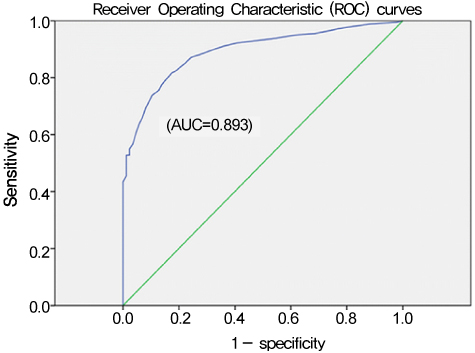J Lipid Atheroscler.
2015 Dec;4(2):109-114. 10.12997/jla.2015.4.2.109.
New Diagnostic Criterion of Ankle Brachial Index for Peripheral Arterial Disease
- Affiliations
-
- 1Department of Internal Medicine, Dae Dong Hospital, Busan, Korea. luxrex@unitel.co.kr
- KMID: 2151818
- DOI: http://doi.org/10.12997/jla.2015.4.2.109
Abstract
- BACKGROUND
The ankle brachial index (ABI) is a simple, inexpensive diagnostic test for peripheral arterial disease (PAD). However the diagnostic criterion of 0.9 has shown variable accuracy for identification of stenosis. We investigated more specific and sensitive diagnostic criterion of ABI for the diagnosis of PAD.
METHODS
Among 5,379 patients who performed ABI test, 398 patients with abnormal ABI results or PAD symptoms underwent computed tomography angiography to confirm PAD. Each ABI results were compared with its sensitivity, specificity, positive and negative predictive values. ROC analysis and cross-tabulation analysis were performed to yield proper ABI criterion.
RESULTS
ABI of 0.9 showed very high level of sensitivity (92.2%) and very low specificity(59.3%). ABI of 0.84 showed high level of specificity (81.4%), sensitivity (82.2%) and diagnostic correspondent rate (0.607).
CONCLUSION
The ABI of 0.84 could be more accurate and useful diagnostic Criterion for identifying PAD.
MeSH Terms
Figure
Reference
-
1. Attinger CE, Beckman J, Criqui M, Froelich JB, Giurini JM, Hamdan A, et al. American Diabetes Association. Peripheral arterial disease in people with diabetes. Diabetes Care. 2003; 26:3333–3341.
Article2. Gregg EW, Sorlie P, Paulose-Ram R, Gu Q, Eberhardt MS, Wolz M, et al. 1999-2000 national health and nutrition examination survey. Prevalence of lower- extremity disease in the US adult population ≥40 years of age with and without diabetes: 1999-2000 national health and nutrition examination survey. Diabetes Care. 2004; 27:1591–1597.
Article3. Peach G, Griffin M, Jones KG, Thompson MM, Hinchliffe RJ. Diagnosis and management of peripheral arterial disease. BMJ. 2012; aug. 14. 345:e5208.
Article4. Heijenbrok-Kal MH, Kock MC, Hunink MG. Lower extremity arterial disease: multidetector CT angiography meta-analysis. Radiology. 2007; 245:433–439.
Article5. Met R, Bipat S, Legemate DA, Reekers JA, Koelemay MJ. Diagnostic performance of computed tomography angiography in peripheral arterial disease: a systematic review and meta-analysis. JAMA. 2009; 301:415–424.
Article6. Hirsch AT, Haskal ZJ, Hertzer NR, Bakal CW, Creager MA, Halperin JL, et al. ACC/AHA Guidelines for the Management of Patients with Peripheral Arterial Disease (Lower Extremity, Renal, Mesenteric, and Abdominal Aortic). Circulation. 2006; 113:1474–1547.
Article7. Khan TH, Farooqui FA, Niazi K. Critical review of the ankle brachial index. Curr Cardiol Rev. 2008; 4:101–106.
Article8. Dachun Xu, Jue Li, Liling Zou, Yawei Xu, Dayi Hu, Pagoto SL, et al. Sensitivity and specificity of the ankle--brachial index to diagnose peripheral artery disease: a structured review. Vasc Med. 2010; 15:361–369.
Article9. Hiatt WR. Medical treatment of peripheral arterial disease and claudication. N Engl J Med. 2001; 344:1608–1621.
Article10. Schaper NC, Andros G, Apelqvist J, Bakker K, Lammer J, Lepantalo M, et al. Diagnosis and treatment of peripheral arterial disease in diabetic patients with a foot ulcer. A progress report of the International Working Group on the Diabetic Foot. Diabetes Metab Res Rev. 2012; 28:Suppl 1. 218–224.
Article11. Criqui MH. Peripheral arterial disease--epidemiological aspects. Vasc Med. 2001; 6:Suppl. 3–7.12. Feigelson HS, Criqui MH, Fronek A, Langer RD, Molgaard CA. Screening for peripheral arterial disease: the sensitivity, specificity, and predictive value of noninvasive tests in a defined population. Am J Epidemiol. 1994; 140:526–534.
Article13. Hirsch AT, Criqui MH, Treat-Jacobson D, Regensteiner JG, Creager MA, Olin JW, et al. Peripheral arterial disease detection, awareness, and treatment in primary care. JAMA. 2001; 286:1317–1324.
Article14. Selvin E, Erlinger TP. Prevalence of and risk factors for peripheral arterial disease in the United States: results from the National Health and Nutrition Examination Survey, 1999-2000. Circulation. 2004; 110:738–743.
Article15. Taylor-Piliae RE, Fair JM, Varady AN, Hlatky MA, Norton LC, Iribarren C, et al. Ankle brachial index screening in asymptomatic older adults. Am Heart J. 2011; 161:979–985.
Article16. Ouriel K, McDonnell AE, Metz CE, Zarins CK. Critical evaluation of stress testing in the diagnosis of peripheral vascular disease. Surgery. 1982; 91:686–693.17. Guo X, Li J, Pang W, Zhao M, Luo Y, Sun Y, et al. Sensitivity and specificity of ankle-brachial index for detecting angiographic stenosis of peripheral arteries. Circ J. 2008; 72:605–610.
Article18. Kock MC, Adriaensen ME, Pattynama PM, van Sambeek MR, van Urk H, Stijnen T, et al. DSA versus multi-detector row CT angiography in peripheral arterial disease: randomized controlled trial. Radiology. 2005; 237:727–737.
Article19. Schernthaner R, Stadler A, Lomoschitz F, Weber M, Fleischmann D, Lammer J, et al. Multidetector CT angiography in the assessment of peripheral arterial occlusive disease: accuracy in detecting the severity, number, and length of stenoses. Eur Radiol. 2008; 18:665–671.
Article20. Ouwendijk R, de Vries M, Pattynama PM, van Sambeek MR, de Haan MW, Stijnen T, et al. Imaging peripheral arterial disease: a randomized controlled trial comparing contrast-enhanced MR angiography and multi-detector row CT angiography. Radiology. 2005; 236:1094–1103.
Article
- Full Text Links
- Actions
-
Cited
- CITED
-
- Close
- Share
- Similar articles
-
- False Normalization of Ankle Brachial Index: A Case of Lower Extremity Peripheral Arterial Disease with Normal Ankle-Brachial Index
- Association between Aging and Changes in the Ankle-Brachial Index after Exercise in Patients with Chest Pain
- Usefulness of ankle brachial pressure index measured using photoplethysmography and automated blood pressure measurement device
- Utility of Toe-brachial Index for Diagnosis of Peripheral Artery Disease
- Diagnosis of Peripheral Artery Disease: Focus on the 2016 American Heart Association/American College of Cardiology and 2017 European Society of Cardiology Guidelines


